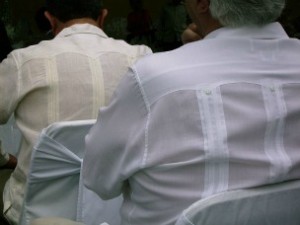Cinco De Mayo: Remembering Yogi Berra And Cojones
 By Tony Castro, Voxxi
By Tony Castro, Voxxi
I REMEMBER MY first Cinco de Mayo, or was it a Dieciséis de septiembre?, parade like it was yesterday. The image that sticks with me most is of my uncle searching desperately for something he had lost.
“Dónde está mi Yogi Berra? Dónde está mi Yogi Berra?”
His question filled the house, where he was living with us at the time. I was around four or five years old, and I remember joining in his desperate search for Yogi Berra.
My uncle’s baseball card collection was his pride and joy, and I could understand why losing one of his prized baseball cards might be upsetting.
“Dónde está mi Yogi Berra?”
Even now, my family gets a good laugh telling the story of how concerned I became at my uncle’s distress and of seeing me running out of my room holding out a card to my beloved uncle in hopes of alleviating his loss.
“Here, here, uncle, you can have my Yogi Berra.”
Turns out, my uncle was looking for his guayabera. Shoot me for being a culturally deprived child. Kid Chicano I was not.
But, as I came to learn, a guayabera is symbolic not only of one’s Mexicanness but of one’s masculinity as well. Call it Viagra in threads. A guayabera is equivalent to cojones that you wear on your sleeve. No guayabera, no cojones.
I am reminded of all that watching the Cinco de Mayo and Mexican Independence parades — and seeing all those powerful Mexican-American men riding in convertibles draped with serapes and reeking of cojones with their crisply starched guayaberas. Appropriately, Mitt Romney, who lays claim to being Mexican, has been out campaigning among Latinos in Florida — in a guayabera no less.
(Glossary for the non-Mexicano: A guayabera is a loose-fitting white shirt with optional decorative stitching on the bib front that is a traditional casual dress for successful Mexican men who want to show their connection to peasant roots.)
My uncle and all the other men in my family each owned guayaberas that I never recall them wearing except to celebrate Mexican holidays.
One of my cousins later wore a guayabera regularly, but that was because he worked as the maitre ‘d at a Mexican restaurant.
I suspect that it may be the same for Mexicans who, for political correctness, must literally wear their heritage on their sleeves.
I doubt that U.S. Rep. Xavier Becerra — who looks quite dapper in a light blue guayabera — ever wears his guayabera much in Washington, D.C.
I mean, I suspect that I’ll never tune in to C-SPAN and hear the voice of the Speaker of the House echoing on the House floor:
“The chair now recognizes the distinguished Congressman with the gua-ya-bera…”
Or take Antonio Villaraigosa, the first Latino elected mayor of Los Angeles since the 1800s. I doubt that I’ll ever see him at City Hall wearing the white guayabera he sports in Mexican holiday parades.
The same for all the other powerful Mexicanos wearing their guayaberas in the parade or throughout the days of Mexican Independence celebration.
For that matter, the only Mexican I’ve ever seen out in public wearing a guayabera — even when it wasn’t a Mexican holiday — is boxer Oscar De La Hoya.
My point exactly.
Los Angeles-based writer Tony Castro is the author of the critically-acclaimed “Chicano Power: The Emergence of Mexican America” (E. P. Dutton, 1974) and the best-selling “Mickey Mantle: America’s Prodigal Son” (Brassey’s, 2002). His rite of passage memoir, “The Prince of South Waco: Images and Illusions of a Youth,” will be published in 2013.
This article was first published in Voxxi.
[Photo by Maurice Marcellin]
